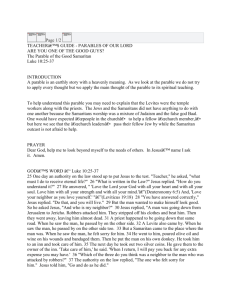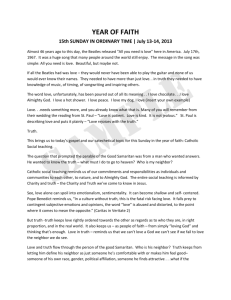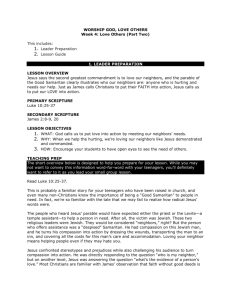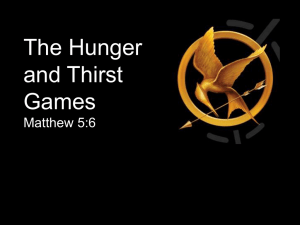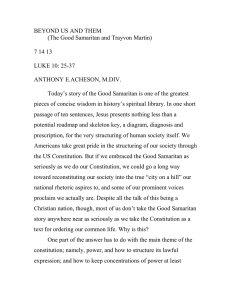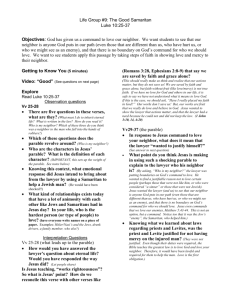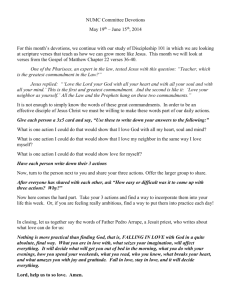Lesson 4 - Unity Church
advertisement
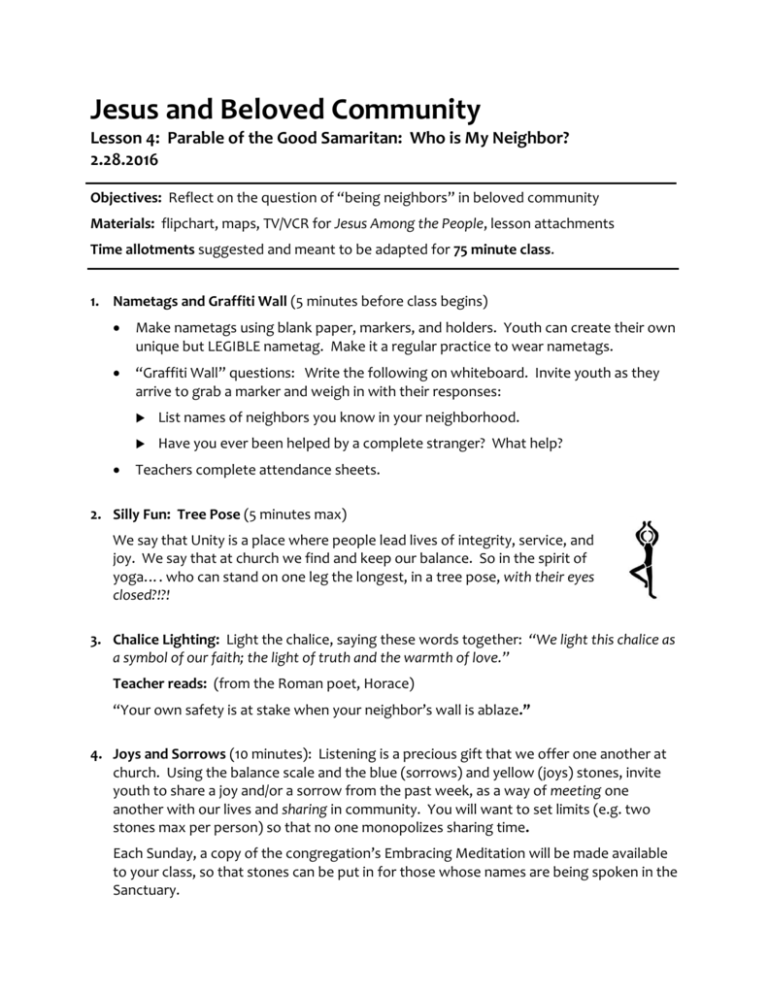
Jesus and Beloved Community Lesson 4: Parable of the Good Samaritan: Who is My Neighbor? 2.28.2016 Objectives: Reflect on the question of “being neighbors” in beloved community Materials: flipchart, maps, TV/VCR for Jesus Among the People, lesson attachments Time allotments suggested and meant to be adapted for 75 minute class. 1. Nametags and Graffiti Wall (5 minutes before class begins) Make nametags using blank paper, markers, and holders. Youth can create their own unique but LEGIBLE nametag. Make it a regular practice to wear nametags. “Graffiti Wall” questions: Write the following on whiteboard. Invite youth as they arrive to grab a marker and weigh in with their responses: List names of neighbors you know in your neighborhood. Have you ever been helped by a complete stranger? What help? Teachers complete attendance sheets. 2. Silly Fun: Tree Pose (5 minutes max) We say that Unity is a place where people lead lives of integrity, service, and joy. We say that at church we find and keep our balance. So in the spirit of yoga…. who can stand on one leg the longest, in a tree pose, with their eyes closed?!?! 3. Chalice Lighting: Light the chalice, saying these words together: “We light this chalice as a symbol of our faith; the light of truth and the warmth of love.” Teacher reads: (from the Roman poet, Horace) “Your own safety is at stake when your neighbor’s wall is ablaze.” 4. Joys and Sorrows (10 minutes): Listening is a precious gift that we offer one another at church. Using the balance scale and the blue (sorrows) and yellow (joys) stones, invite youth to share a joy and/or a sorrow from the past week, as a way of meeting one another with our lives and sharing in community. You will want to set limits (e.g. two stones max per person) so that no one monopolizes sharing time. Each Sunday, a copy of the congregation’s Embracing Meditation will be made available to your class, so that stones can be put in for those whose names are being spoken in the Sanctuary. 5. Map of Palestine (5 minutes) Pass out maps of Palestine and help youth familiarize themselves with the map: What and where are the three major regions of Palestine at this time in the first century? (Answer: Galilee, Samaria, Judea) Where is the holy city of Jerusalem? If someone were traveling from Galilee to Jerusalem, what area would they pass through? The people in Galilee were called _________? (Answer: Galileans) The people in Judea were called _________? (Answer: Judeans) The people in Samaria were called _________? (Answer: Samaritans) 6. Video: Parable of The Good Samaritan (10 minutes) Show video: Jesus Among the People (about 5 minutes) [scene begins with map showing Galilee through Samaria to Judea, and stop with scene of Jesus walking with disciples.] Teacher summarizes from video: While Galileans and Judeans were largely Jewish, Samaritans were not Jews. They may have shared some religious beliefs and practices with Jews, but they believed only in Moses and the first five books of the Jewish scriptures called Torah. They rejected the oral law and newer thinking of Judaism. Jews, in turn, looked down on Samaritans as mixed-breed people whose religion was diluted. There was such malice between Jews and Samaritans that it was not safe for any Jew to travel alone through Samaria, or vice versa. For those listening to Jesus’ parable of the Good Samaritan, the very notion of a “good Samaritan” would have been a contradiction. 7. Read through Parable of the Good Samaritan (20 minutes) Pass out attached handout Ask for 3 volunteers to read aloud (narrator, lawyer, and Jesus) Questions for Discussion: Why do the priest and Levite both pass by without helping the wounded man? (Answer: recall from the video, that touching the bleeding/unclean man would have made them ritually unclean for a period of time and would require ritual purification, during which time they could not perform their regular religious duties. Helping entangles us and isn’t always so cut and dry!) How might helping someone today make you feel “unclean” or “guilty” by association? (Hint: Think about white allies during Civil Rights, or if youth sided with someone being bullied at school.) Given his Jewish audience, why would Jesus choose a Samaritan as the unlikely hero of the parable? Who are some “Samaritans” or unlikely heroes of today? (Muslim leaders who lead interfaith dialogue? Perhaps for liberal-minded people, conservative Republicans who run community shelters and food shelves?) What distinguishes the “beloved community” from any other community? (Hint: radical welcome and inclusion of those marginalized, rejected by mainstream society, and even those who are our enemies.) Martin Luther King, Jr. once said about this parable: “The first question which the priest and the Levite asked was: ‘If I stop to help this man, what will happen to me?’ But...the good Samaritan reversed the question: ‘If I do not stop to help this man, what will happen to him?’” What do you think about that? In the “beloved community,” is it about me, the other, both, God, or what? 8. Who is My Neighbor?: Meditative Moment (15 minutes) **Important note: Please read through carefully and learn activity by heart, so teachers can be attentive to dynamics in the room. Have youth sit in a circle, chairs facing out and eyes closed. This exercise will be purely for themselves and will NOT be asked to share anything they do not wish to share. Invite youth to center/focus on their breath, taking slower, deeper breaths. Explain that this will be a guided meditation, inviting them further into the question “Who is my neighbor?” When the room has quieted, teacher reads the following sentences… slowly… pausing between each reading: The parable of the Good Samaritan asks about being a neighbor to someone in need, even when it may be difficult because of social boundaries about whom to help or not help. It’s not always so clear…So just imagine now, seeing a new kid in school eating alone during lunchtime, looking sad and awkward. Would you likely go over to say hello and ask if you can join? (pause for quiet reflection) Would it make a difference if the new student was a guy or a girl?... Notice if your body or heart or mind reacts at all to that. (pause for quiet reflection) What if the new student fit the stereotype of a “nerd”…or “jock”… or “stoner”… or “heavy metal/goth”? Again, notice if your body or heart or mind reacts at all. (pause for quiet reflection) Would it make a difference to going over and joining the new student… if the new student was in a wheelchair, or showed physical disabilities? (pause for quiet reflection) What if the new student was wearing a rainbow symbol of gay pride… or was wearing a Jesus and cross symbols? (pause for quiet reflection) Would it make a difference to going over and joining the new student… if the new student was Hmong… or Somali wearing a headscarf… or was black American? Notice if your body or heart or mind reacts at all to any of these. (pause for quiet reflection) Invite youth to again center/focus on breathing… and slowly open their eyes… and turn their chairs around to face into the circle. This exercise was for youth to personally register the challenges of being a neighbor across social boundaries. But it may be helpful for some youth to share any general reflections/feelings they found from this exercise. Invite any sharing from youth as needed, but keep this brief and NOT allow it to become a discussion. 9. Mission to Be a Neighbor: (10 minutes) Hand out attachment “Mission: Being a Neighbor” and invite youth to consider more consciously being a neighbor to those who are overlooked, marginalized, and rejected. Ask youth to complete the form which will NOT be shared but intended for themselves. Encourage them to put it somewhere where they can be reminded of being a neighbor and creating the beloved community. 10. Say goodbye until next time: Extinguish the chalice, saying together: “May the light of truth and the warmth of love go with us in our hearts.” 11. Help clean up classroom before leaving: Please keep regular practice of readying classroom for the next class. leave lesson plan and all materials organized return blue/yellow stones to containers wipe the whiteboard clean tables and chairs neatly returned nametags collected in Ziploc bag leave any comments for RE staff on attendance sheets
